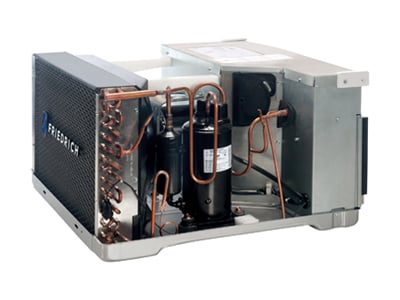Room air conditioners remove heat from indoor air and transfer it outdoors. Cool air is then returned to the room. The cycle continues until the indoor air reaches the “set point,” or the desired temperature on your thermostat.
Cool refrigerant gas is pumped into the compressor where it is—you guessed it—compressed, which heats the refrigerant. The hot refrigerant gas then passes through the condenser coil, where it is cooled, and changes from a gas to a liquid. This liquid runs through an expansion device, which further cools the gas as it enters the evaporator coil. This cooler gas collects moisture (in the form of water beads on the outside evaporator coil surface) and heat from the air to be cooled. The cooled air is then returned to the room and the process repeats until the room temperature reaches the desired set point.
The compressor pumps and heats the refrigerant, increasing the temperature and pressure of the gas. The hot gas passes through coils, loses heat and condenses into a liquid. This liquid runs through an expansion valve and evaporates to become cold, low-pressure gas. The cold gas passes through a set of coils that cools the air. A fan blows the cool air into the room.
Your air conditioner also removes moisture from the air, which makes the room feel much more comfortable.
An air filter traps airborne dust, dirt and debris, keeping the inside room air cleaner by maintaining evaporator coil cleanliness. Regular filter cleaning helps ensure this important function’s effectiveness and prolong the life of a unit.
My grandmother has a Friedrich Quietmaster at her house, which she likes to keep very cold. Everyday in the summer she has it on high and the temperature on cold. For 44 years the unit was in operation from April to October. Just this summer it gave way and we got a Friedrich Kühl. I’m really impressed with the quality.
Nick



